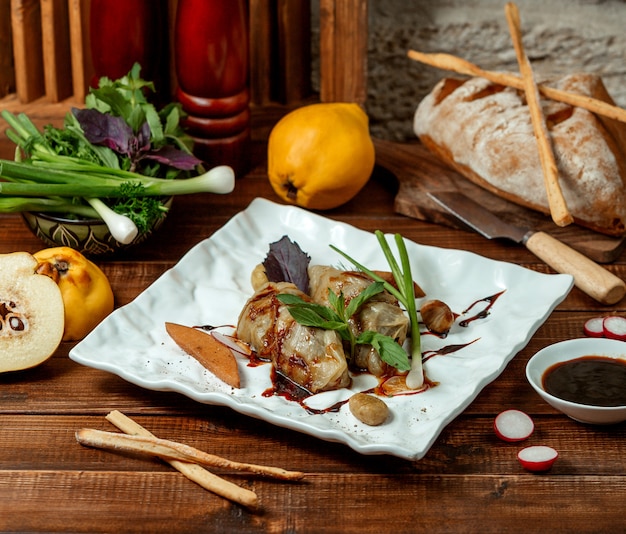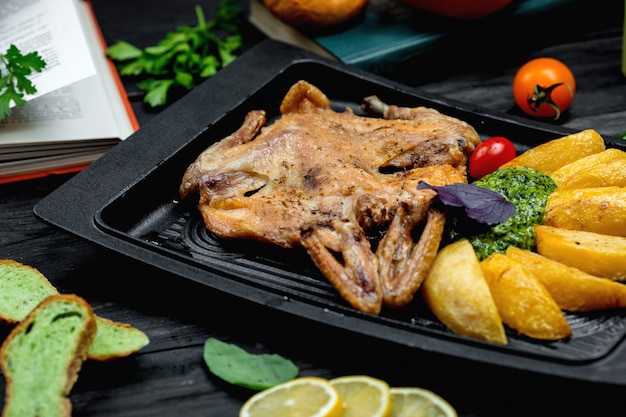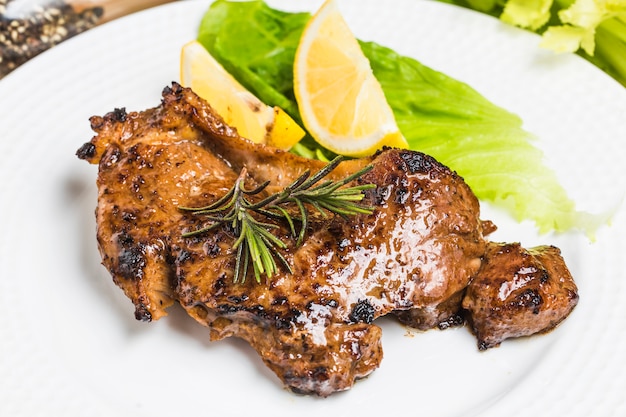Ah, lamb chops. They're a real treat, aren't they? Perfectly cooked, with that delicious, slightly gamey flavour and juicy, tender meat. But let's be honest, cooking them to perfection can feel like a bit of a culinary gamble. One minute they're juicy and pink, the next they're dry and tough. But fear not, my friend! This guide is going to be your secret weapon for mastering lamb chops, turning those occasional culinary mishaps into triumphant feasts.
We'll cover everything from selecting the best cuts and unlocking the secrets of perfect seasoning to mastering different cooking techniques. We'll even explore the importance of resting time and discover the ideal side dishes that complement those juicy lamb chops perfectly. So, grab your apron, put on your favourite playlist, and let's embark on a culinary journey to lamb chop heaven!
(Part 1) Choosing Your Lamb Chops

The Cut: A Guide to Choosing the Right One
The first step to delicious lamb chops is choosing the right cut. It's not just about picking a random package from the supermarket. There are a few popular choices, each with its own unique characteristics that cater to different tastes and cooking preferences.
rack of lamb: This is the classic choice, consisting of a row of ribs with the meat attached. It's a showstopper for special occasions, offering impressive presentation and tender, flavourful meat. Think of it as the VIP of the lamb chop world.
Lamb Chops: These individual chops are cut from the loin and can be found in various sizes, typically around 1-inch thick. They're perfect for a quick and easy weeknight meal, offering a satisfying portion size without being overwhelming.
Lamb Cutlets: These are thinner chops, often cut from the shoulder or leg. They cook quickly and are ideal for grilling or pan-frying, perfect for a light and delicate meal.
Picking the Perfect Chops: What to Look For
Once you've decided on your cut, it's time to pick out the perfect chops. Here's what to look for, ensuring you're getting the best possible quality:
Color: The meat should be a lovely, rich red colour, not pale or discoloured. This indicates freshness and quality.
Marbling: Look for a good amount of marbling – that's the white streaks of fat running through the meat. It's like the secret ingredient for tenderness and flavour.
Smell: The lamb should smell fresh and slightly gamey, not sour or unpleasant. This is a sign that it hasn't been sitting around for too long.
Thickness: Choose chops that are about 1-inch thick. This allows for even cooking and a juicy, tender result, as opposed to thin chops that can easily overcook.
The Butcher: A Treasure Trove of Knowledge
Here's a secret I've learned over the years: I prefer to buy my lamb chops from my local butcher. They always have the freshest cuts, and you can chat with them about what you're looking for. They can even tell you about the best cuts for different cooking methods. Plus, they're usually happy to trim the chops for you, saving you a bit of prep time.
(Part 2) Seasoning Secrets: Unleashing Flavor

The Foundation of Flavor: Basic Seasoning
Lamb is a versatile meat, and it lends itself well to a variety of seasonings. Here's a simple, classic seasoning blend that always works:
Salt: Use sea salt or kosher salt for the best flavour. They offer a more complex flavour than regular table salt.
Black Pepper: Freshly ground black pepper is essential for a bit of heat. Don't use pre-ground pepper, the freshness makes a world of difference.
Garlic Powder: Adds a lovely depth of flavour, giving the lamb a subtle garlicky aroma.
Onion Powder: Enhances the natural sweetness of the lamb, adding a touch of oniony goodness.
Beyond the Basics: Get Creative with Seasonings
Once you've mastered the basics, feel free to experiment with other seasonings. Here are a few of my favourites, adding a touch of international flair:
Mediterranean Blend: A combination of oregano, rosemary, thyme, and a pinch of red pepper flakes. It gives the lamb a vibrant, earthy flavour with a hint of warmth.
Herbes de Provence: A classic French blend with a mix of herbs like thyme, rosemary, oregano, marjoram, and lavender. This adds a delicate, aromatic touch, perfect for a sophisticated meal.
Curry Powder: For a spicy, flavorful twist. This adds a rich, complex flavour with a touch of heat.
Tips for Perfect Seasoning: The Art of Timing
Season generously: Don't be shy with the seasonings. Lamb can handle a bit more than you might think, allowing the flavours to really shine.
Season in advance: Seasoning the chops a few hours before cooking allows the flavours to really penetrate the meat. This gives the flavours time to develop and meld together.
Don't overcrowd the pan: If you're pan-frying, make sure you don't overcrowd the pan. This can lower the temperature and prevent the chops from getting a good sear.
(Part 3) Cooking Techniques: Mastering the Art of Lamb

Grilling: Bringing Out the Smoky Flavor
Grilling is a classic method for cooking lamb chops. It imparts a delicious smoky flavour and a nice char that adds a touch of rustic charm.
Preheat the grill: Get your grill nice and hot, preferably over medium-high heat. This ensures the chops get a good sear and cook evenly.
Sear the chops: Place the chops directly on the grill grates and cook for 3-4 minutes per side, until they're nicely seared and have a good char. This creates a beautiful crust, locking in the juices.
Cook to your preference: Continue grilling, turning occasionally, until the internal temperature reaches your desired level of doneness.
Rest the chops: Once cooked, remove the chops from the grill and let them rest for 5-10 minutes before serving. This allows the juices to redistribute throughout the meat, resulting in a juicy, tender chop.
Pan-Frying: Quick, Juicy, and Delicious
Pan-frying is another great way to cook lamb chops, especially if you're short on time. It offers a crispy exterior and a juicy interior.
Heat the pan: Heat a heavy-bottomed skillet over medium-high heat. A hot pan ensures a good sear.
Add oil: Add a good amount of oil to the pan, enough to coat the bottom. Olive oil or a blend of oil and butter works well.
Sear the chops: Place the chops in the hot pan and cook for 3-4 minutes per side, until they're nicely seared and have a good crust. This creates that beautiful golden brown colour.
Reduce the heat: Reduce the heat to medium-low and continue cooking, turning occasionally, until the chops are cooked through.
Rest the chops: Once cooked, remove the chops from the pan and let them rest for 5-10 minutes before serving.
Roasting: Bringing Out Tenderness and Flavor
Roasting is a great option for larger cuts of lamb, like a rack of lamb. It's a slow and steady cooking method, resulting in incredibly tender meat.
Preheat the oven: Preheat your oven to 350°F (175°C). A preheated oven ensures even cooking.
Season the chops: Season the chops generously with your favorite blend of seasonings. Don't be shy with the seasoning, lamb loves flavour!
Place the chops in a roasting pan: Arrange the chops in a roasting pan, bone-side down. This allows the bones to transfer heat to the meat more evenly.
Roast the chops: Roast the chops for 15-20 minutes per pound, or until the internal temperature reaches your desired level of doneness.
Rest the chops: Once cooked, remove the chops from the oven and let them rest for 10-15 minutes before carving and serving.
(Part 4) Doneness Guide: Lamb Chop Temperatures
Understanding Doneness: A Guide to perfect lamb
It's important to know how to check the doneness of your lamb chops to avoid overcooking them. Overcooked lamb can be dry and tough, so aim for the perfect level of doneness.
Rare: 125°F (52°C) - The meat will be red in the center and very tender.
Medium-Rare: 130°F (54°C) - The meat will be pink in the center and slightly firmer.
Medium: 140°F (60°C) - The meat will be slightly pink in the center and more firm.
Medium-Well: 150°F (65°C) - The meat will be mostly brown in the center and firm.
Well-Done: 160°F (71°C) - The meat will be fully cooked and brown in the center.
Using a meat thermometer: A Culinary Must-Have
The best way to check the doneness of your lamb chops is with a meat thermometer. It's the most accurate way to ensure you're cooking the lamb to your desired level of doneness. Insert the thermometer into the thickest part of the chop, making sure it doesn't touch the bone.
Other Ways to Check Doneness: If You Don't Have a Thermometer
Pressing: If you're not using a meat thermometer, you can check doneness by pressing on the meat. If it's still very soft and bouncy, it's rare. As it cooks, it will become firmer.
Color: Lamb chops will change color as they cook. They'll go from a deep red to a medium pink to a light brown.
(Part 5) Resting Time: A Key to Juicy Chops
The Science Behind Resting: Why It's Essential
Resting your lamb chops after cooking is crucial for achieving juicy, flavorful results. It's not just a suggestion, it's a critical step in the process.
Redistributing Juices: When you cook the lamb, the juices flow to the center of the meat. Resting allows the juices to redistribute evenly throughout the chop, preventing them from running out when you cut into it.
Improving Tenderness: Resting also allows the muscle fibers to relax, which improves the tenderness of the meat.
How Long to Rest: The Magic Number
Grilling: 5-10 minutes
Pan-Frying: 5-10 minutes
Roasting: 10-15 minutes
The Right Way to Rest: The Art of Patience
Cover the chops: Cover the chops loosely with foil to help trap the heat and moisture.
Place in a warm spot: Place the chops in a warm spot, like a preheated oven or on a serving platter.
(Part 6) Side Dishes: Perfect Pairings
Classic Combinations: A Symphony of Flavors
Lamb chops are a versatile meat that pair well with a variety of side dishes. Here are a few classic combinations, guaranteed to elevate your meal:
Roasted Vegetables: Roasted vegetables, like asparagus, Brussels sprouts, carrots, or potatoes, bring a nice contrast in texture and flavour. The roasting process adds a touch of sweetness and caramelization.
Couscous: Fluffy couscous is a light and refreshing accompaniment to the richness of the lamb. Its neutral flavour lets the lamb shine while providing a satisfying texture.
Polenta: Creamy polenta is a delicious and comforting side dish. Its creamy texture provides a comforting contrast to the lamb's richness.
More Creative Options: Stepping Outside the Box
If you're looking for something a little more adventurous, try these side dishes, adding a touch of innovation to your meal:
fruit salad: A touch of sweetness from a fruit salad cuts through the richness of the lamb. Think citrusy fruits like oranges, grapefruits, or pineapple for a refreshing counterpoint.
green beans with Almonds: crispy green beans with toasted almonds add a bit of crunch. This brings a contrasting texture and a light, nutty flavour.
Mint Sauce: A classic British condiment that adds a refreshing touch to the lamb. The minty flavour cuts through the richness of the lamb, offering a refreshing and palate-cleansing finish.
Table Setting for a Feast: Creating a Memorable Experience
When it comes to presentation, I like to go all out. A beautiful table setting makes the entire meal feel more special, transforming it into a truly memorable experience.
White Linen Tablecloth: For a classic and elegant look, a crisp white tablecloth is always a good choice. It adds a touch of formality and sophistication.
Silverware: Choose elegant silverware to complement the tablecloth and enhance the overall look of the table setting. Silverware adds a touch of class and elegance.
Elegant Dinnerware: Beautiful plates and bowls elevate the presentation of the food. Choose dinnerware that complements the overall aesthetic of the meal.
Floral Arrangements: A centerpiece with fresh flowers adds a touch of colour and fragrance to the table. Flowers bring a sense of life and beauty to the setting.
(Part 7) Serving Your perfect lamb chops
The Finishing Touches: Bringing it All Together
Carve the lamb chops: Use a sharp knife to carve the chops into individual portions. A sharp knife makes the carving process clean and precise.
Arrange the chops on a platter: Arrange the chops artfully on a serving platter. Consider using a platter that complements the overall aesthetic.
Garnish with fresh herbs: Add a sprig of fresh rosemary or thyme to each chop for a touch of colour and flavour. Fresh herbs add a burst of freshness and aroma.
Serve with your chosen side dishes: Arrange the side dishes alongside the lamb chops on the platter. A balanced presentation makes the meal more appealing.
Tips for Serving: Ensuring a Delicious Experience
Serve immediately: Lamb chops are best served hot, so try to serve them as soon as they are cooked. This ensures the lamb stays juicy and flavorful.
Don't overcook: It's better to serve the lamb chops a little bit pink than to overcook them. Overcooked lamb can be dry and tough.
Enjoy!: Finally, relax, enjoy your meal, and savour the delicious flavour of your perfectly cooked lamb chops!
(Part 8) FAQs
1. What is the best way to prevent lamb chops from becoming tough?
The key to preventing tough lamb chops is to avoid overcooking them. Overcooked lamb is dry and tough. Use a meat thermometer to check the internal temperature, and make sure the chops are cooked to your desired level of doneness. Also, rest the chops for 5-10 minutes after cooking, allowing the juices to redistribute and the muscle fibers to relax.
2. What should I do if my lamb chops are too dry?
If your lamb chops are too dry, you can try to add moisture back into them by adding a sauce or gravy. You can also try pan-searing them in a bit of butter or olive oil before serving to create a flavorful crust.
3. How can I make lamb chops more flavorful?
Experiment with different seasonings and marinades to add flavour to your lamb chops. You can also use a flavorful cooking method, such as grilling or pan-frying, to enhance the flavour.
4. What are the best side dishes for lamb chops?
Lamb chops pair well with a variety of side dishes, including roasted vegetables, couscous, polenta, fruit salad, green beans with almonds, and mint sauce. Choose side dishes that complement the flavor of the lamb and provide a nice contrast in texture.
5. How do I store leftover lamb chops?
Leftover lamb chops can be stored in the refrigerator for up to 3-4 days. To store them, wrap them tightly in plastic wrap or aluminum foil. You can also freeze leftover lamb chops for up to 3 months. To freeze them, wrap them tightly in plastic wrap and then place them in a freezer-safe bag.
Everyone is watching

Corn on the Cob: The Ultimate Guide to Perfectly Cooked Ears
Healthy MealsAh, corn on the cob. Just the name evokes images of sunny days, barbecues, and that sweet, juicy flavour that ...

Perfect Pork Roast Oven Cooking Time: A Guide to Delicious Results
Healthy MealsThere's something truly satisfying about a perfectly roasted pork. The aroma alone is enough to make your mout...

Ham Cooking Time: How Long to Bake, Smoke, or Boil a Delicious Ham
Healthy MealsAh, ham. It's a classic, isn't it? A real crowd-pleaser, especially around holidays. And when done right, it'...

Scallops: The Ultimate Guide to Perfect Cooking
Healthy MealsAh, scallops. Those delicate, sweet, and utterly delicious morsels of the sea. They hold a special place in my...

Spaghetti Squash: The Ultimate Guide to Cooking and Serving
Healthy MealsRemember that time you saw spaghetti squash at the supermarket, looking all bumpy and strange, and thought, "W...
